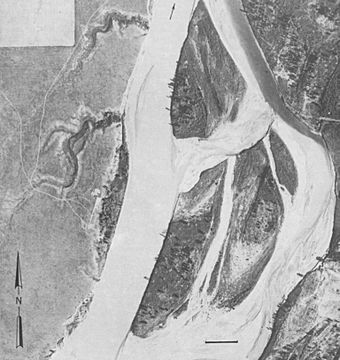Hagen Site facts for kids
|
Hagen Site
|
|

1938 aerial photo of the site
|
|
| Lua error in Module:Location_map at line 420: attempt to index field 'wikibase' (a nil value). | |
| Nearest city | Glendive, Montana |
|---|---|
| Built | 1550 |
| NRHP reference No. | 66000432 |
Quick facts for kids Significant dates |
|
| Added to NRHP | October 15, 1966 |
| Designated NHL | July 19, 1964 |
The Hagen Site is a very important archaeological site located near Glendive, Montana in Dawson County, Montana. It's also known by a special code, 24DW1, which is a Smithsonian trinomial used by scientists.
Scientists believe this site shows us a rare moment in history. It might be where the Crow and Hidatsa Native American tribes began to separate and become distinct groups. Because of its importance, the Hagen Site was named a National Historic Landmark in 1964.
Contents
The Hagen Site: An Ancient Mystery
The Hagen Site is found on a flat area next to the Yellowstone River. This spot is north of Glendive. A dry creek bed, called an arroyo, runs along its east and north sides.
Archaeologists found several interesting features built by ancient people here. These include a large pit that might have been an earth lodge, which is a type of home. They also found special storage pits, called cache pits, and places where fires were made, known as hearths.
What Was Found at Hagen?
During the excavations in the 1930s, over 20,000 artifacts were discovered at the Hagen Site! These finds included many broken pieces of pottery, tools made from stone, and animal bones. They also found some traces of ancient human activity.
These artifacts help us learn about the daily lives of the people who lived there long ago.
Digging Up the Past
The Hagen Site was first found in 1936 by Oscar Lewis. He was a local person who loved archaeology. The site is named after the landowner at that time.
Later that year, a team funded by the National Youth Administration program studied the site. More serious digs happened in 1937 and 1938. These were organized by the state and funded by the Works Progress Administration.
During these early digs, the teams recorded where artifacts were found on the ground. However, they didn't record how deep each artifact was. This makes it harder for today's scientists to fully understand the collection.
Clues About Ancient Cultures
The things found at the Hagen Site suggest that people lived there and grew crops. This way of life is similar to how the Hidatsa people lived. However, most other known Hidatsa sites are much further east, near the Missouri River in North Dakota.
The pottery found at Hagen looks a bit like pottery made by the Crow people. But scientists are still debating exactly what makes Crow pottery unique. The missing depth information from the Hagen collection makes this question even harder to answer.
Even with these challenges, the Hagen Site is very important. It helps us learn about the ancient history of the region and the Native American tribes who lived there.

